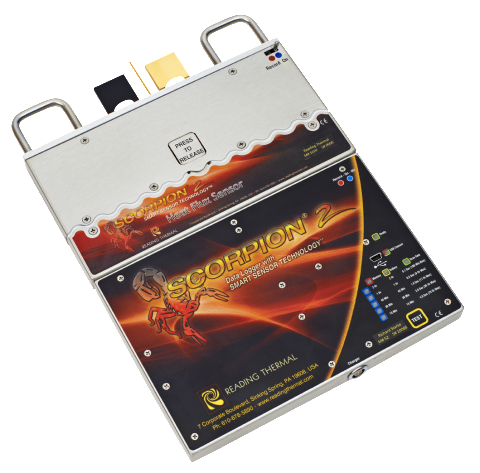If your crackers or biscuits come off the belt with dark edges and pale centers, you’re seeing classic “edge effects.” Side walls radiate heat, airflow hugs the edges and moisture escapes faster along the band rails. You can fight this with brute-force temperature changes, but the cleaner fix often starts with time – specifically, how you distribute dwell time across the tunnel. Reading Thermal offers unsurpassed thermal profiling of industrial ovens to determine optimal baking times for snack production. We can help you get rid of those edge effects once and for all.
Find The Imbalance Before You Turn A Knob
Time adjustments work best when you know where the product actually falls behind. That’s where profiling earns its keep. Run Reading Thermal’s SCORPION® 2 with the Temperature Sensor Array across the belt to see edge-to-center conditions at product level, then add the Heat Flux Sensor to capture the energy the dough truly receives. Those two readings will tell you if the center is starved early, in the middle, or right before exit.
If airflow is part of the story, a quick pass with the Digital Air Velocity Sensor Array will show whether the outer lanes are getting a push the middle never sees. Armed with a few profiles, you’ll know whether you need more time overall or simply a smarter placement of the time you already have.
Slow Down A Little, Then Give Time Where It Counts
A small line-speed change – sometimes just a couple of percentage points – can give the center enough dwell to reach color and moisture targets. The trick is not to hand the edges the same “bonus time.” The practical way to do that is by rebalancing where dwell is most effective.
Keep early zones slightly gentler so the edges don’t sprint ahead in the first third of the tunnel, then let the mid-zone do more of the heavy lifting. You’re not chasing a perfectly flat temperature profile; you’re shaping the cumulative energy curve so the center catches up while the edges stop accelerating. Your SCORPION® 2 Heat Flux Sensor makes this obvious – you’ll see the middle lane’s cumulative curve line up with your golden run even after a small speed change.
Create A Mid-Zone “Soak” Without Sacrificing Crunch
When the middle of the belt is pale, a brief “soak” is your friend. Give the product a little more time in the middle third by easing back on speed and trimming late-zone aggressiveness so edges don’t over-brown during the extra seconds.
If humidity plays a role, verify it with the Digital Humidity Sensor. Sometimes a quick tweak to exhaust or make-up air keeps the surface from drying too fast at the edges, buying you the mid-zone dwell you need for the center to set and color evenly. None of this has to be dramatic – small changes, confirmed by profiles, usually do the trick.
Validate With Golden Curves, Not Hunches
Once you see a perfect tray, capture it. Save the cross-belt temperature, heat-flux, and, if relevant, humidity signatures as your “golden curves.” Next time pale centers appear, make one change at a time and overlay the new run on your reference in the SCORPION® 2 software. If your adjustment added time where it matters, the center lanes’ cumulative energy will snap back to the golden shape while the edge lanes hold steady. That’s your signal you’ve fixed the imbalance rather than trading one defect for another.
Find out more about how thermal profiling of industrial ovens to determine optimal baking times for snack production can help address these and other issues. Call Reading Thermal at 610-678-5890 or use our online contact form to get in touch.

